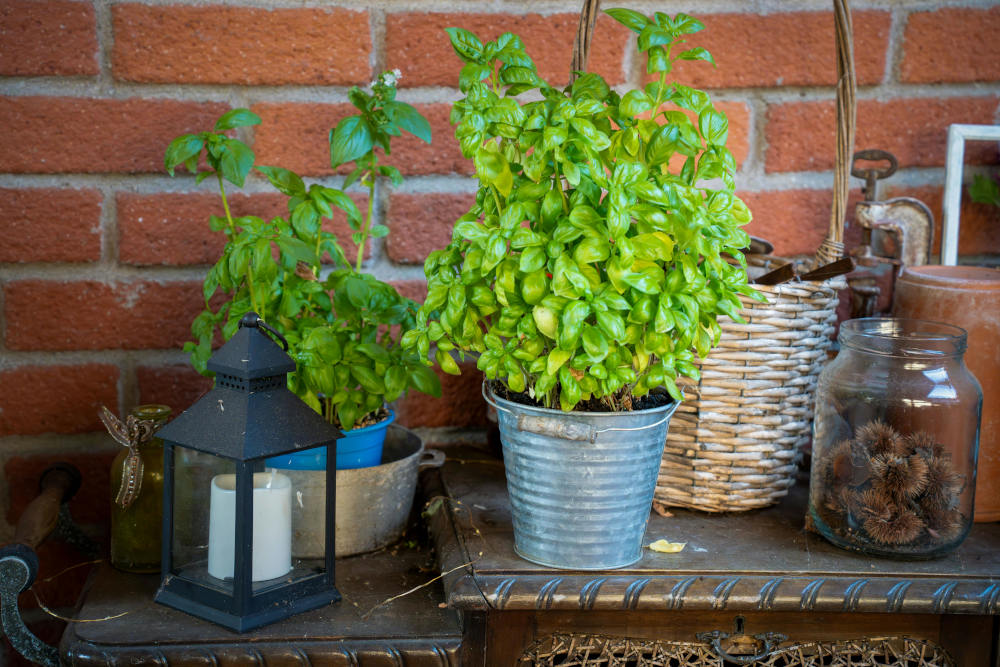
Planting herbs outside in pots is one of the most rewarding ways to start a garden. Whether you're growing basil for your pasta, mint for iced tea, or lavender for fragrance, potted herbs can thrive on patios, balconies, and windowsills.
But the key to success lies in timing. So, when can you safely plant herbs outdoors in containers?
The short answer: After the last frost date in your area, when daytime and nighttime temperatures are consistently warm. But it’s not one-size-fits-all. The best planting time depends on your climate, the herb variety, and how you prepare your pots.
This guide will walk you through everything you need to know—from understanding frost dates to choosing the right herbs for each season.
Panaprium is independent and reader supported. If you buy something through our link, we may earn a commission. If you can, please support us on a monthly basis. It takes less than a minute to set up, and you will be making a big impact every single month. Thank you!
Why Timing Matters
Herbs are sensitive to cold. Planting too early can lead to stunted growth or even kill your plants. Especially in pots, where the soil warms and cools faster than the ground, it's crucial to plant when conditions are stable.
Cold-sensitive herbs like basil and cilantro are easily damaged by a surprise frost.
Hardy herbs like chives and thyme can tolerate cooler temperatures and can be planted earlier.
Knowing when to plant depends on:
-
Your USDA Hardiness Zone
-
Last frost date
-
The specific herb’s hardiness
-
Daytime and nighttime temperatures
General Rule: After the Last Frost Date
Most herbs should be planted after the last expected spring frost in your region. You can look up your local last frost date using zip-code-based tools or USDA planting zone charts.
Examples:
-
Zone 3 (Northern U.S./Canada): Late May to early June
-
Zone 5–6 (Midwest/Northeast): Mid to late April
-
Zone 7–8 (Mid-South): Early to mid-April
-
Zone 9–10 (Southern U.S.): February to March
Wait until nighttime temperatures are consistently above 50°F (10°C) before putting out tender herbs.
Planting Herbs in Pots vs. In-Ground
Planting herbs in pots offers flexibility—but pots also:
-
Heat up faster, so herbs grow sooner in spring.
-
Cool off quicker, making roots more vulnerable to cold snaps.
-
Require more frequent watering and care.
That’s why pot-grown herbs should not be placed outside too early, even if your garden soil is warming up.
Best Time to Plant Herbs by Type
Let’s break it down by herb. Here are common herbs grouped by their seasonal planting needs:
❄️ Cold-Hardy Herbs (Can Go Out Early – Even Before Last Frost with Protection)
These can tolerate light frost and cool soil.
-
Parsley
-
Chives
-
Thyme
-
Oregano
-
Mint
-
Sage
-
Lavender
Planting Time: 2–3 weeks before last frost, especially if hardened off or covered at night.
🌤️ Warm-Season Herbs (Wait Until After Last Frost)
These herbs hate cold and need warmth to thrive.
-
Basil
-
Cilantro
-
Dill
-
Tarragon
-
Lemongrass
-
Stevia
Planting Time: 1–2 weeks after last frost, when nights are reliably above 50°F.
🌱 Biennials or Perennials with Flexibility
These can survive cooler temps but prefer to grow in stable weather.
-
Rosemary (Tender perennial—bring inside in winter)
-
Marjoram
-
Fennel
-
Bay Laurel (Slow-growing but worth it)
Planting Time: After last frost, or earlier if brought in at night.
How to Prepare Before Planting Outside
Planting herbs in pots isn’t just about the date—it’s about preparation. Here’s what to do to set your potted herbs up for success.
1. Check Your Frost Date
Use reliable resources like:
-
USDA Plant Hardiness Zone Map
2. Harden Off Indoor Seedlings
If you started herbs indoors, gradually get them used to outdoor conditions by placing them outside for a few hours a day over 7–10 days. Increase time and sun exposure daily.
3. Choose the Right Containers
-
Use pots with good drainage holes.
-
Larger pots retain moisture better and protect roots.
-
Avoid thin plastic pots that heat up too fast or crack in cold.
4. Use Quality Potting Mix
Herbs in pots need light, well-draining soil. Mix compost or coconut coir for moisture retention and nutrients.
5. Position Your Pots Wisely
Most herbs need 6+ hours of direct sun per day.
-
South- or west-facing areas work best.
-
If you're in a hot region, some herbs like cilantro benefit from afternoon shade.
Signs It’s Safe to Plant Outside
You’ll know it’s time to plant herbs outdoors in pots when:
-
Night temperatures stay above 50°F (10°C)
-
No frost is in the 10-day forecast
-
Soil in your pots stays above 55°F (13°C)
-
You’ve hardened off indoor plants
-
Daytime temps reach 60–70°F (15–21°C) consistently
What If You Plant Too Early?
Planting early can be tempting—but it carries risks:
-
Cold shock stunts growth or kills tender herbs.
-
Slow root development in cold soil.
-
Diseases from overwatering in cool, damp conditions.
If you've already planted and a cold snap is coming, protect your herbs with:
-
Row covers
-
Plastic tunnels
-
Old sheets or towels at night
-
Moving pots inside overnight
Tips for Year-Round Container Herb Gardening
You can grow herbs outside in pots almost year-round with the right strategies:
Spring:
-
Start hardy herbs early.
-
Transition seedlings outside.
-
Watch for late frosts.
Summer:
-
Water frequently—potted herbs dry out fast.
-
Harvest often to encourage new growth.
Fall:
-
Cut back and harvest herbs.
-
Bring tender herbs indoors if frost is coming.
Winter:
-
Only hardy herbs may survive in pots outdoors (e.g., thyme, chives).
-
Insulate pots or move them into a greenhouse.
Common Mistakes to Avoid
-
Planting basil too early. It's very cold-sensitive.
-
Using garden soil in pots. It compacts and lacks drainage.
-
Overwatering. Wet roots + cold temps = root rot.
-
Skipping the hardening-off process. Shocks tender plants.
-
Ignoring sunlight needs. Herbs love sun—don’t place them in constant shade.
Final Thoughts: When to Plant Herbs Outside in Pots
You can plant herbs outside in pots once danger of frost has passed, nighttime temps stay above 50°F, and the soil is warm. Cold-hardy herbs like thyme and chives can go out earlier, while tender ones like basil must wait for real warmth.
Herbs grown in containers are easy to manage, quick to harvest, and portable—just be sure to watch the weather, prepare your pots well, and choose the right herbs for the season.
Quick Reference Table:
| Herb | Planting Time Outside (Pots) | Cold Sensitivity |
|---|---|---|
| Basil | 1–2 weeks after last frost | Very sensitive |
| Mint | 2–3 weeks before last frost | Hardy |
| Thyme | 2–3 weeks before last frost | Hardy |
| Rosemary | After last frost | Needs warm temps |
| Chives | 2–3 weeks before last frost | Hardy |
| Cilantro | Just after last frost | Cool-season preferred |
| Parsley | 2–3 weeks before last frost | Hardy biennial |
| Oregano | Just after last frost | Hardy |
| Dill | After last frost | Cold-sensitive seedling |
| Lavender | After last frost | Needs sun, well-drained |
Sources:
-
USDA Plant Hardiness Zone Map
-
Almanac.com
-
Royal Horticultural Society (RHS)
-
University Extension Gardening Guides (Penn State, Oregon State, etc.)
Was this article helpful to you? Please tell us what you liked or didn't like in the comments below.
About the Author: Alex Assoune
What We're Up Against
Multinational corporations overproducing cheap products in the poorest countries.
Huge factories with sweatshop-like conditions underpaying workers.
Media conglomerates promoting unethical, unsustainable products.
Bad actors encouraging overconsumption through oblivious behavior.
- - - -
Thankfully, we've got our supporters, including you.
Panaprium is funded by readers like you who want to join us in our mission to make the world entirely sustainable.
If you can, please support us on a monthly basis. It takes less than a minute to set up, and you will be making a big impact every single month. Thank you.































0 comments